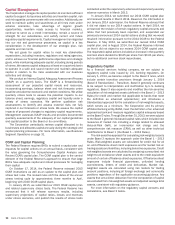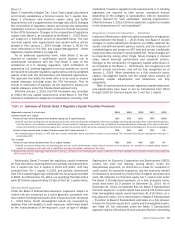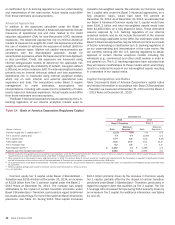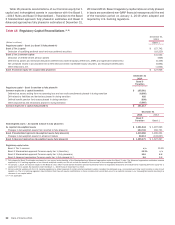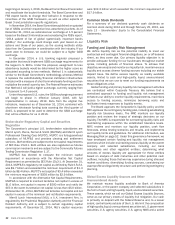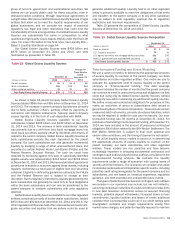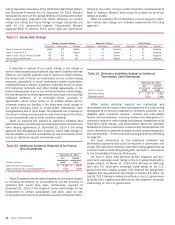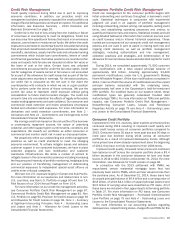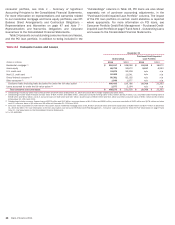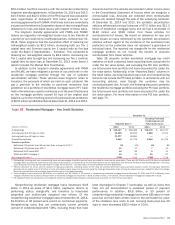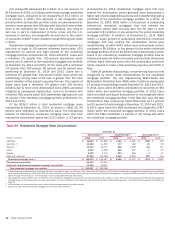Bank of America 2014 Annual Report Download - page 67
Download and view the complete annual report
Please find page 67 of the 2014 Bank of America annual report below. You can navigate through the pages in the report by either clicking on the pages listed below, or by using the keyword search tool below to find specific information within the annual report.
Bank of America 2014 65
Table 20 presents our long-term debt by major currency at
December 31, 2014 and 2013.
Table 20 Long-term Debt by Major Currency
December 31
(Dollars in millions) 2014 2013
U.S. Dollar $ 191,264 $ 176,294
Euro 30,687 46,029
British Pound 7,881 9,772
Japanese Yen 6,058 9,115
Australian Dollar 2,135 1,870
Canadian Dollar 1,779 2,402
Swiss Franc 897 1,274
Other 2,438 2,918
Total long-term debt $ 243,139 $ 249,674
Total long-term debt decreased $6.5 billion, or three percent,
in 2014, primarily driven by maturities outpacing new issuances.
We may, from time to time, purchase outstanding debt instruments
in various transactions, depending on prevailing market conditions,
liquidity and other factors. In addition, our other regulated entities
may make markets in our debt instruments to provide liquidity for
investors. For more information on long-term debt funding, see
Note 11 – Long-term Debt to the Consolidated Financial
Statements.
We use derivative transactions to manage the duration, interest
rate and currency risks of our borrowings, considering the
characteristics of the assets they are funding. For further details
on our ALM activities, see Interest Rate Risk Management for Non-
trading Activities on page 102.
We may also issue unsecured debt in the form of structured
notes for client purposes. Structured notes are debt obligations
that pay investors returns linked to other debt or equity securities,
indices, currencies or commodities. We typically hedge the returns
we are obligated to pay on these liabilities with derivative positions
and/or investments in the underlying instruments, so that from a
funding perspective, the cost is similar to our other unsecured
long-term debt. We could be required to settle certain structured
liability obligations for cash or other securities prior to maturity
under certain circumstances, which we consider for liquidity
planning purposes. We believe, however, that a portion of such
borrowings will remain outstanding beyond the earliest put or
redemption date. We had outstanding structured liabilities with a
carrying value of $38.8 billion and $48.4 billion at December 31,
2014 and 2013.
Substantially all of our senior and subordinated debt
obligations contain no provisions that could trigger a requirement
for an early repayment, require additional collateral support, result
in changes to terms, accelerate maturity or create additional
financial obligations upon an adverse change in our credit ratings,
financial ratios, earnings, cash flows or stock price.
Contingency Planning
We maintain contingency funding plans that outline our potential
responses to liquidity stress events at various levels of severity.
These policies and plans are based on stress scenarios and
include potential funding strategies and communication and
notification procedures that we would implement in the event we
experienced stressed liquidity conditions. We periodically review
and test the contingency funding plans to validate efficacy and
assess readiness.
Our U.S. bank subsidiaries can access contingency funding
through the Federal Reserve Discount Window. Certain non-U.S.
subsidiaries have access to central bank facilities in the
jurisdictions in which they operate. While we do not rely on these
sources in our liquidity modeling, we maintain the policies,
procedures and governance processes that would enable us to
access these sources if necessary.
Credit Ratings
Our borrowing costs and ability to raise funds are impacted by our
credit ratings. In addition, credit ratings may be important to
customers or counterparties when we compete in certain markets
and when we seek to engage in certain transactions, including
OTC derivatives. Thus, it is our objective to maintain high-quality
credit ratings, and management maintains an active dialogue with
the rating agencies.
Credit ratings and outlooks are opinions expressed by rating
agencies on our creditworthiness and that of our obligations or
securities, including long-term debt, short-term borrowings,
preferred stock and other securities, including asset
securitizations. Our credit ratings are subject to ongoing review by
the rating agencies and they consider a number of factors,
including our own financial strength, performance, prospects and
operations as well as factors not under our control. The rating
agencies could make adjustments to our ratings at any time and
they provide no assurances that they will maintain our ratings at
current levels.
Other factors that influence our credit ratings include changes
to the rating agencies’ methodologies for our industry or certain
security types, the rating agencies’ assessment of the general
operating environment for financial services companies, the
sovereign credit ratings of the U.S. government, our mortgage
exposures (including litigation), our relative positions in the
markets in which we compete, reputation, liquidity position,
diversity of funding sources, funding costs, the level and volatility
of earnings, corporate governance and risk management policies,
capital position, capital management practices, and current or
future regulatory and legislative initiatives.
All three agencies have indicated that, as a systemically
important financial institution, the senior credit ratings of the
Corporation and Bank of America, N.A. (or in the case of Moody’s
Investors Service, Inc. (Moody’s), only the ratings of Bank of
America, N.A.) currently reflect the expectation that, if necessary,
we would receive significant support from the U.S. government,
and that they will continue to assess such support in the context
of sovereign financial strength and regulatory and legislative
developments.
On December 2, 2014, Standard & Poor’s Ratings Services
(S&P) affirmed the ratings of Bank of America, and revised the
outlook on our core operating subsidiaries, including Bank of
America, N.A., MLPF&S, and MLI, to stable from negative. The
negative outlook on the ratings of Bank of America Corporation
reflects S&P’s ongoing evaluation of whether to continue to include
uplift for extraordinary U.S. government support in the ratings of
systemically-important BHCs. On November 25, 2014, Fitch
Ratings (Fitch) concluded their periodic review of 12 large, complex
securities trading and universal banks, including Bank of America
Corporation. As a result of this review, Fitch affirmed all of the
Corporation’s credit ratings and retained a negative outlook. The
negative outlook reflects Fitch’s expectation that the probability of
the U.S. government providing support to a systemically important
financial institution during a crisis is likely to decline due to the



